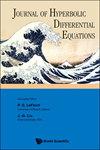半线性阻尼波模型中强时变振荡的影响
IF 0.5
4区 数学
Q4 MATHEMATICS, APPLIED
引用次数: 0
摘要
本文研究了一类具有强时变振荡的半线性阻尼波模型的Cauchy问题的小数据解的全局(实时)存在性。目标是理解系数中的强振荡对一些具有“类有效”阻尼项的半线性模型的解的影响,其中数据应该属于不同类别的正则性。本文章由计算机程序翻译,如有差异,请以英文原文为准。
Influence of strong time-dependent oscillations in semilinear damped wave models
We study the global (in time) existence of small data solutions to some Cauchy problems for semilinear damped wave models with strong time-dependent oscillations. The goal is to understand the influence of strong oscillations in the coefficients on solutions to some semilinear models with an “effective-like” damping term, where the data are supposed to belong to different classes of regularity.
求助全文
通过发布文献求助,成功后即可免费获取论文全文。
去求助
来源期刊

Journal of Hyperbolic Differential Equations
数学-物理:数学物理
CiteScore
1.10
自引率
0.00%
发文量
15
审稿时长
24 months
期刊介绍:
This journal publishes original research papers on nonlinear hyperbolic problems and related topics, of mathematical and/or physical interest. Specifically, it invites papers on the theory and numerical analysis of hyperbolic conservation laws and of hyperbolic partial differential equations arising in mathematical physics. The Journal welcomes contributions in:
Theory of nonlinear hyperbolic systems of conservation laws, addressing the issues of well-posedness and qualitative behavior of solutions, in one or several space dimensions.
Hyperbolic differential equations of mathematical physics, such as the Einstein equations of general relativity, Dirac equations, Maxwell equations, relativistic fluid models, etc.
Lorentzian geometry, particularly global geometric and causal theoretic aspects of spacetimes satisfying the Einstein equations.
Nonlinear hyperbolic systems arising in continuum physics such as: hyperbolic models of fluid dynamics, mixed models of transonic flows, etc.
General problems that are dominated (but not exclusively driven) by finite speed phenomena, such as dissipative and dispersive perturbations of hyperbolic systems, and models from statistical mechanics and other probabilistic models relevant to the derivation of fluid dynamical equations.
Convergence analysis of numerical methods for hyperbolic equations: finite difference schemes, finite volumes schemes, etc.
 求助内容:
求助内容: 应助结果提醒方式:
应助结果提醒方式:


